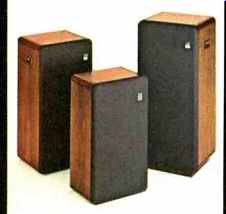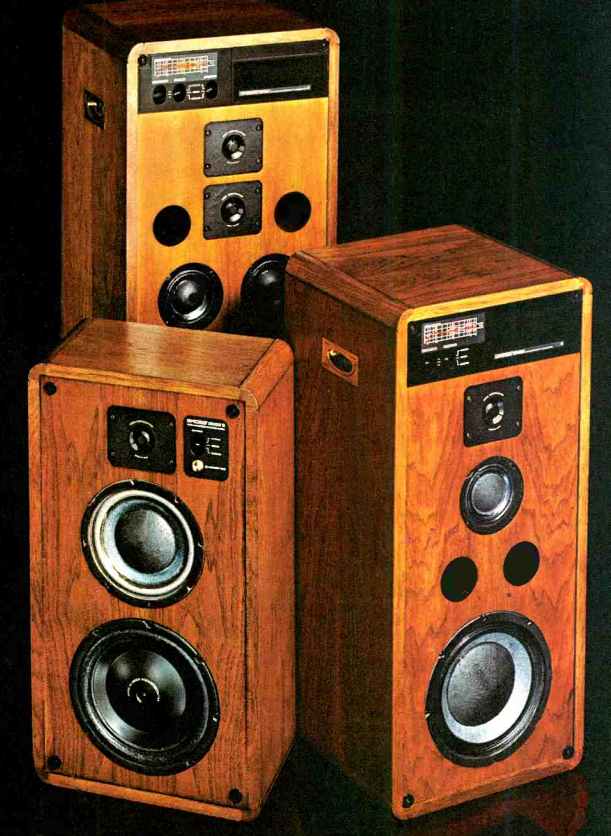Introducing the Koss Theory of loudspeaker design and the three new Koss CM speaker systems that prove it.


When Koss invented the stereophone, music lovers and audio experts were amazed at the low distortion, broadband frequency response, and high efficiency achieved by the Koss drivers. Indeed, the resultant Sound of Koss created a revolution in the audio industry.
Today, the exciting new Koss Theory of loudspeaker design has created another revolution.
By developing a complex series of audio engineering formulas and by utilizing the precise knowledge of modern computer science, Koss engineers have created a breakthrough in loudspeaker technology of such significance that it heralds the second major revolution in loudspeaker design technology.
For the first time, it's now possible to scientifically derive and produce the optimum system parameters for any loudspeaker.
By computerizing the Koss Theory and by first selecting the number of bandpasses desired in the system, the system's desired efficiency, the full low bass cutoff, and the desired cabinet size; Koss engineers are able to derive specific design parameters for every component in the total system. In fact the Koss Theory is so sophisticated that even the structural design of the cabinet and the precise positioning of the components in the cabinet for optimum dispersion and phase coherency are specified.
Of course, what's really important is not the Koss Theory itself but the sound of the three new Koss speakers that prove it. Indeed, with current technology, there are no speakers available at similar prices that can match the Koss CM 1010 two bandpass loudspeaker, the Koss CM 1020 three bandpass loudspeaker or the Koss CM 1030 four bandpass loudspeaker in low distortion, high efficiency, and broadband frequency response.
But then, the incredible sound of these three new speakers isn't surprising when you consider some of the revolutionary new features they offer: Take for example, the CM 1010's unique mass aligned 10-inch passive radiator that enhances the lower 2 octaves of the bass and allows for the use of a specially designed 8-inch woofer to reproduce the critical midrange up to 2.5 kHz. With the alignment mass in place, the CM 1010 reproduces a maximally flat response from an f3 of 35 Hz on outward. However, by removing the alignment mass, those who prefer more acoustic energy in the 50 to 80 Hz range can create an f3 of 40 Hz and a low bass ripple of P% dB centering on 60 Hz.
Or take the CM 1020's dual port design that provides an optimal cross sectional port area for proper cabinet tuning. Or the unique parallel midrange design of the CM 1030. By utilizing two 4 3/4-inch drivers operating in parallel, Koss engineers were able to decrease the excursion of each driver thus creating a dramatic decrease in potential driver distortion and an equally exciting increase in the overall brilliance and presence of the midrange response. Then again there's the Koss high bandpass 1-inch dome tweeter and unique acoustic transformer that creates an incredible 6 dB increase in headroom.
And, of course, there's also the patented quasi second-order crossover network that provides a smooth, acoustically invisible transition from bandpass to bandpass.
But those are just some of the revolutionary features offered by the new Koss CM loudspeakers.
Why not prove the Koss Theory of loudspeaker design to yourself by asking your Audio Dealer to give you a full demonstration of the beautiful Sound of Koss. Or write to Fred Forbes, c/o the Koss Corporation, for our free, full color CM loudspeaker brochure. Once you've heard these revolutionary new loudspeakers, we think you'll agree: hearing is believing.
Koss CM SPEAKER SYSTEMS hearing is believing.
KOSS CORPORATION, 1129 N. Port Washington Ave., Milwaukee, Wisconsin 5312, USA.
(Source: Audio magazine, Nov. 1977)
= = = =